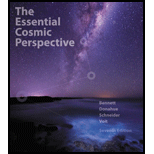
The Essential Cosmic Perspective (7th Edition) - Standalone book
7th Edition
ISBN: 9780321928085
Author: Jeffrey O Bennett, Megan O. Donahue, Nicholas Schneider, Mark Voit
Publisher: PEARSON
expand_more
expand_more
format_list_bulleted
Concept explainers
Textbook Question
Chapter 1, Problem 9EAP
Briefly explain Earth’s daily rotation and annual orbit, defining the terms ecliptic plane and axis tilt.
Expert Solution & Answer
Want to see the full answer?
Check out a sample textbook solution
Students have asked these similar questions
No chatgpt pls will upvote
No chatgpt pls will upvote
Defination of voltage
Chapter 1 Solutions
The Essential Cosmic Perspective (7th Edition) - Standalone book
Ch. 1 - Prob. 1VSCCh. 1 - Prob. 2VSCCh. 1 - About how far away from Earth would the Sun be...Ch. 1 - Prob. 4VSCCh. 1 - Prob. 1EAPCh. 1 - Define astronomical unit and light-year.Ch. 1 - Explain the statement The farther away we look in...Ch. 1 - Prob. 4EAPCh. 1 - Prob. 5EAPCh. 1 - What do we mean when we say that the universe is...
Ch. 1 - In what sense are we “star stuff”?Ch. 1 - Use the cosmic calendar to describe how the human...Ch. 1 - Briefly explain Earth’s daily rotation and annual...Ch. 1 - Prob. 10EAPCh. 1 - Prob. 11EAPCh. 1 - Prob. 12EAPCh. 1 - Prob. 13EAPCh. 1 - Prob. 14EAPCh. 1 - Decide whether the statement makes sense (or is...Ch. 1 - Prob. 16EAPCh. 1 - Prob. 17EAPCh. 1 - Prob. 18EAPCh. 1 - Decide whether the statement makes sense (or is...Ch. 1 - Prob. 20EAPCh. 1 - Decide whether the statement makes sense (or is...Ch. 1 - Prob. 22EAPCh. 1 - Prob. 23EAPCh. 1 - An astronomical unit is (a) any planet’s average...Ch. 1 - The star Betelgeuse s about 600 light-years away....Ch. 1 - Prob. 26EAPCh. 1 - Prob. 27EAPCh. 1 - Prob. 28EAPCh. 1 - Prob. 29EAPCh. 1 - Prob. 30EAPCh. 1 - Prob. 31EAPCh. 1 - Prob. 32EAPCh. 1 - Prob. 33EAPCh. 1 - Thinking About Scale. One key to success m science...Ch. 1 - Prob. 35EAPCh. 1 - Prob. 36EAPCh. 1 - Prob. 37EAPCh. 1 - Prob. 38EAPCh. 1 - Prob. 39EAPCh. 1 - Prob. 40EAPCh. 1 - Prob. 41EAPCh. 1 - Moonlight and Sunlight. How long does it take...Ch. 1 - Prob. 43EAPCh. 1 - Driving Trips. Imagine that you could drive your...Ch. 1 - Prob. 45EAPCh. 1 - 48. Vast Orbs. Dutch astronomer Christiaan Huygens...Ch. 1 - Prob. 47EAPCh. 1 - Prob. 48EAPCh. 1 - Prob. 49EAPCh. 1 - Prob. 50EAPCh. 1 - Prob. 51EAP
Knowledge Booster
Learn more about
Need a deep-dive on the concept behind this application? Look no further. Learn more about this topic, physics and related others by exploring similar questions and additional content below.Similar questions
- At point A, 3.20 m from a small source of sound that is emitting uniformly in all directions, the intensity level is 58.0 dB. What is the intensity of the sound at A? How far from the source must you go so that the intensity is one-fourth of what it was at A? How far must you go so that the sound level is one-fourth of what it was at A?arrow_forwardMake a plot of the acceleration of a ball that is thrown upward at 20 m/s subject to gravitation alone (no drag). Assume upward is the +y direction (and downward negative y).arrow_forwardLab Assignment #3 Vectors 2. Determine the magnitude and sense of the forces in cables A and B. 30° 30° 300KN 3. Determine the forces in members A and B of the following structure. 30° B 200kN Name: TA: 4. Determine the resultant of the three coplanar forces using vectors. F₁ =500N, F₂-800N, F, 900N, 0,-30°, 62-50° 30° 50° F₁ = 500N = 900N F₂ = 800Narrow_forward
- Lab Assignment #3 Vectors Name: TA: 1. With the equipment provided in the lab, determine the magnitude of vector A so the system is in static equilibrium. Perform the experiment as per the figure below and compare the calculated values with the numbers from the spring scale that corresponds to vector A. A Case 1: Vector B 40g Vector C 20g 0 = 30° Vector A = ? Case 2: Vector B 50g Vector C = 40g 0 = 53° Vector A ? Case 3: Vector B 50g Vector C 30g 0 = 37° Vector A = ?arrow_forwardThree point-like charges are placed at the corners of an equilateral triangle as shown in the figure. Each side of the triangle has a length of 20.0 cm, and the point (A) is located half way between q1 and q2 along the side. Find the magnitude of the electric field at point (A). Let q1=-1.30 µC, q2=-4.20µC, and q3= +4.30 µC. __________________ N/Carrow_forwardNo chatgpt pls will upvotearrow_forward
- Find the total capacitance in micro farads of the combination of capacitors shown in the figure below. HF 5.0 µF 3.5 µF №8.0 μLE 1.5 µF Ι 0.75 μF 15 μFarrow_forwardthe answer is not 0.39 or 0.386arrow_forwardFind the total capacitance in micro farads of the combination of capacitors shown in the figure below. 2.01 0.30 µF 2.5 µF 10 μF × HFarrow_forward
arrow_back_ios
SEE MORE QUESTIONS
arrow_forward_ios
Recommended textbooks for you
 AstronomyPhysicsISBN:9781938168284Author:Andrew Fraknoi; David Morrison; Sidney C. WolffPublisher:OpenStax
AstronomyPhysicsISBN:9781938168284Author:Andrew Fraknoi; David Morrison; Sidney C. WolffPublisher:OpenStax
 Stars and GalaxiesPhysicsISBN:9781305120785Author:Michael A. Seeds, Dana BackmanPublisher:Cengage Learning
Stars and GalaxiesPhysicsISBN:9781305120785Author:Michael A. Seeds, Dana BackmanPublisher:Cengage Learning Foundations of Astronomy (MindTap Course List)PhysicsISBN:9781337399920Author:Michael A. Seeds, Dana BackmanPublisher:Cengage Learning
Foundations of Astronomy (MindTap Course List)PhysicsISBN:9781337399920Author:Michael A. Seeds, Dana BackmanPublisher:Cengage Learning Stars and Galaxies (MindTap Course List)PhysicsISBN:9781337399944Author:Michael A. SeedsPublisher:Cengage Learning
Stars and Galaxies (MindTap Course List)PhysicsISBN:9781337399944Author:Michael A. SeedsPublisher:Cengage Learning

Astronomy
Physics
ISBN:9781938168284
Author:Andrew Fraknoi; David Morrison; Sidney C. Wolff
Publisher:OpenStax


Stars and Galaxies
Physics
ISBN:9781305120785
Author:Michael A. Seeds, Dana Backman
Publisher:Cengage Learning

Foundations of Astronomy (MindTap Course List)
Physics
ISBN:9781337399920
Author:Michael A. Seeds, Dana Backman
Publisher:Cengage Learning

Stars and Galaxies (MindTap Course List)
Physics
ISBN:9781337399944
Author:Michael A. Seeds
Publisher:Cengage Learning

General Relativity: The Curvature of Spacetime; Author: Professor Dave Explains;https://www.youtube.com/watch?v=R7V3koyL7Mc;License: Standard YouTube License, CC-BY